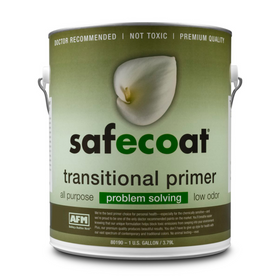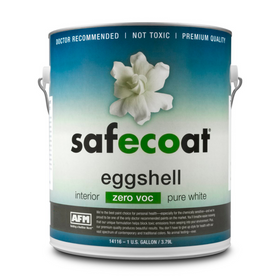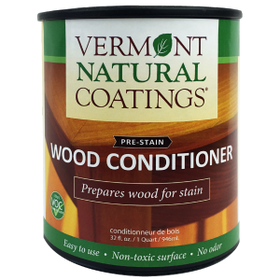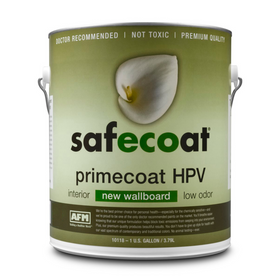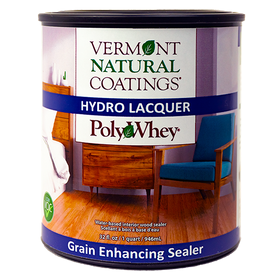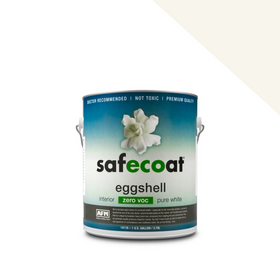Rise

A Guide to Low and Zero-VOC Paint
Last Updated: Apr 9, 2025A fresh coat of paint has the power to completely transform a room and how we feel while in it. We might choose a soothing pastel to welcome a new baby or freshen a drab nook with a bold hue to inspire creativity. Studies show that the color of one's environment can influence the body. Purple, for example, affects the body's circadian rhythm and can help reduce feelings of stress.
But there is more to paint than just color. Each manufacturer uses a slightly different paint formula, including volatile organic compounds, also known as VOCs. These paints may look great on the wall, but silently off-gas dangerous chemicals that could harm you and your family.
Low and zero-VOC paint contains fewer if any VOCs and is a much safer choice for your family and the environment.
Table of Contents
- What are Volatile Organic Compounds (VOCs)?
- What is Low or No-VOC Paint?
- Why VOCs Are In Paint Matter
- How Long Does Low-VOC Paint Off Gas?
- How Can You Speed Up Off-Gassing?
- Can You Trust Low-VOC Labels?
- Is it Safe to Paint When You Are Pregnant?
- Is Low or No-VOC Paint Safe for Babies?
- Is Low or No-VOC Paint Safe for Pets?
- Can You Buy Non-Toxic Spray Paint?
- Choosing Low or No-VOC Paint
- What Are the Best No or Low-VOC Paint Brands?
- Start Your Low or No-VOC Painting Project Now

What are Volatile Organic Compounds (VOCs)?
Volatile organic compounds (VOCs) are chemicals that are added to paint and other household products. VOCs are often added to paint to improve how well it adheres to walls, decrease dry time, and keep it looking fresh for years, but those added chemicals add a whole lot of trouble.
VOCs commonly found in paint include formaldehyde, chloride, methylene, and benzene. Exposure has been linked to respiratory and exocrine system problems, including, but not limited to, trouble breathing, headaches, nausea, cancer, fatigue, dizziness, itchy skin/rash, poor coordination, and nose, throat, and eye irritation.
What is Low or No-VOC Paint?
Low and no-VOC paint is safer paint options specially formulated to contain fewer if any VOCs. These paints limit or eliminate toxic off-gassing, keeping everyone safer and healthier.

Why VOCs Are In Paint Matter
You work hard to keep your family healthy, but all the organic produce in the world won't protect you from the toxins you invite into your home.
VOCs are often invisible and odorless and can continue to off-gas toxic chemicals for years. Paint is the top source of VOC emissions in the entire world, coming second only to vehicles.
The VOCs present in your home pollute your air, seep into carpets and furniture, and can even escape your house and pollute the air in your neighborhood.
The Environmental Protection Agency (EPA) estimates that the things we choose to bring into our homes decrease our indoor air quality significantly. They say that these things contribute to VOC levels as much as two to five times higher than the air just outside your door.
The Clean Air Act aims to improve air quality by limiting the amount of VOCs manufacturers can include in paint and other products. Under this act, the EPA limits paint to no more than 250 grams of VOCs per liter of flat paint and no more than 380 grams per liter of low luster, semi-gloss, and glossy paints.
Some manufacturers have chosen to use an earth-friendly base, like plant oils, for their paints, while others remove the toxic VOCs from existing paints. According to Greenguard, it is generally accepted that paint should contain fewer than 50 grams of VOCs per liter to qualify as low-VOC paint and less than 5 grams per liter for paints claiming zero VOCs.
As more manufacturers work to develop safer paints, prices for low and zero-VOC paints have come down considerably. This makes them a viable option, even for budget-conscious home improvement projects. You can also request low and zero-VOC paint samples from many paint stores to see how they dry and hold up in your home.
How Long Does Low-VOC Paint Off Gas?
The duration and intensity of paint-related off-gassing are primarily dependent on the type of paint used, how long it takes to cure, and how many coats are applied. Most latex paints, for example, off-gas for roughly three to five years, but can continue up to 10 years.
Off-gassing is strongest during and immediately after painting a surface. If you've ever painted before, you're probably familiar with the smell of paint. That smell is a good indicator that paint containing VOCs is currently off-gassing. Still, it will continue to release toxins into the air long after the scent dissipates.
While there is no way to eliminate off-gassing except by using 100% zero-VOC paint, it is possible to speed up the process.
How Can You Speed Up Off-Gassing?
It's always best to allow interior paint to dry entirely before inhabiting the space. However, for many of us, that just isn't possible. If staying with friends, family, or at a hotel is out of the question, there are ways to help paint dry and off-gas quicker.

Encourage Good Ventilation
Paint will dry quicker in a room that is well ventilated. Please open the windows while you paint and leave them open as long as possible while the paint dries. You might also keep a fan running to speed things up further. Remember to keep doors closed when painting a single room to limit the spread of VOCs throughout your home.
Introduce Heat
When finished painting, you might choose to run a heater to increase the evaporation rate of off-gassed VOCs. Of course, running the heat with windows open isn't ideal for energy efficiency, making you set a timer to turn the heat off.
Decrease Indoor Humidity
Paint dries and cures much faster in dry air. If you paint on a humid day, you might consider running a dehumidifier in the space to speed up off-gassing. If you use a humidifier or anything else to increase indoor humidity regularly, be sure to shut it off while painting.
Purify the Air
While purifying the air won't speed up off-gassing, it can help proactively remove VOCs from the air as they're released. If you have an air-purifying device, keep it running while the paint dries and for several days following. You can also place indoor plants in the room to help absorb the VOCs quicker. Popular air-filtering indoor plants include the Boston Fern, English Ivy, Peace Lilies, and Variegated Snake Plants.
Can You Trust Low-VOC Labels?
When buying anything, it's essential to read paint labels and manufacturer information to ensure you're buying true low or zero-VOC paint. There is still not much regulation on the types of VOCs that can be used in paint. Some low-VOC paints may still contain harmful toxins like ammonia or acetone. Extended exposure to ammonia can cause eye and skin irritation and has even been shown to cause and exacerbate lung damage.

Many companies practice greenwashing, a sales and marketing trend that is designed to mislead customers. Some paint cans may boast "green" or "eco" practices, while the ingredients label tells an entirely different story.
The Federal Trade Commission (FTC) was recently forced to take action against the misleading claims made by Benjamin Moore, ICP Construction Inc., YOLO Colorhouse, and Imperial Paints about their own low and zero-VOC paints.
However, there are tools to help you ensure the paint you're buying is truly low or zero-VOC. Third-party certifications, including Greenguard, Scientific Certification Systems (SCS), and the Green Seal Certification, are awarded only to paints that abide by their strict VOC regulations. You can find these logos on the front label of safe paints when browsing the aisles at your local home improvement store.
Keep in mind that while paint may not contain any VOCs, VOCs are often added when tinting the paint to your chosen color. Some colors, significantly darker shades, can add as much as 150 grams of VOCs per liter. To avoid these surprise VOCs, look for paints approved under the SQAQMD-113 regulation. This regulation first started in California and has been adopted nationwide to regulate the VOCs both in the paint base and in tint additions.
Is it Safe to Paint When You Are Pregnant?
Expectant mothers should take extra precautions during painting projects. The best way to protect an unborn baby is to hire a professional painter and for the mother to steer clear of newly painted areas. If you absolutely must paint the nursery a new color or refinish baby furniture while nesting, it's essential to take extra precautions. Even zero-VOC paint in a pastel color can contain up to 5 grams of VOCs per liter.

Exposure to VOCs in the paint can lead to birth defects and learning delays and even increase miscarriage.
If painting the baby's dresser or crib is on your list, ask someone to help you move the furniture outside to paint in the open air, where you'll have less exposure to off-gassing VOCs. If you're painting the nursery walls, remember to keep those windows open to keep air flowing. Taking lots of fresh air breaks will help too. If you begin to feel dizzy or nauseous, stop painting immediately, as these can be dangerous signs of VOC exposure.
Pregnant women should keep their skin, eyes, and mouth covered while painting by wearing long sleeves, pants, gloves, and a mask and change into clean clothes when finished. Avoid spending extra time in the room by taking pictures to review your progress outside and leaving the room to eat or drink. It's best for pregnant women to wait at least a few days after painting before spending any time in the room.

Is Low or No-VOC Paint Safe for Babies?
Babies and children are especially vulnerable to the effects of VOCs in paint. Children with asthma, sensitive skin and other respiratory conditions should be kept away from painting projects. Remember, even zero-VOC paint can still contain a small amount of VOCs.
Is Low or No-VOC Paint Safe for Pets?
Paint can be incredibly dangerous and even fatal to pets, especially small pets like birds and hamsters. Even when using zero-VOC paint, it's best to move pet cages to another area for a few weeks while paint cures.
Can You Buy Non-Toxic Spray Paint?
Some people prefer to use spray paint for smaller projects like furniture. If that sounds like you, look for low, and zero VOC spray paints. However, these can be hard to find and spray paint may need to be avoided if you want to maintain low-VOC levels in your space.
Choosing Low or No-VOC Paint
As our understanding of VOCs grows, more and more low and zero-VOC paints are entering the market. Below are just a few low and no-VOC paints currently available. Remember to check the paint can label for third-party certifications and ingredient lists before you purchase it.

What Are the Best No or Low-VOC Paint Brands?
Benjamin Moore
Benjamin Moore makes a variety of paints, including their line of Natura Waterborne paint. This one-coat paint boasts zero-VOCs, is spatter resistant, and is certified asthma and allergy-friendly.

Sherwin Williams
Harmony by Sherwin Williams is a single coat zero-VOC paint that also contains antimicrobial agents to prevent mold and mildew from growing. Harmony has been awarded the Greenguard Gold Certification. It maintains its zero-VOC formula even when color is added through Sherwin Williams' ColorCast Ecotoner® colorant system.

Real Milk Paint Company
Based in Tennessee, Real Milk Paint Company produces zero-VOC paints that can be purchased ready to use or in a kit to be mixed at home. Their unique milk paint formula is lime-based to help clean your indoor air rather than pollute it, and it dries in just half an hour.

AFM Safecoat
AFM Safecoat is a non-toxic, zero-VOC paint specially designed for allergy sufferers and other chemically sensitive individuals, like children and pets.

Behr
Behr's Premium Plus paint can be found exclusively at Home Depot. Premium Plus is a zero-VOC self-priming paint that goes on with minimal odor. It is also mildew resistant. Behr offers the Paint Your Place app to conveniently upload home photos to see how colors look in your home. You can even create custom color palettes with Behr's Pins to Palettes Pinterest integration.

Start Your Low or No-VOC Painting Project Now
Have you been thinking about renovating an outdated space or adding a little luxury to your master bathroom?
Whether you plan to do a complete remodel or just make a few key improvements, a fresh coat of paint can make a world of difference. Choosing low or no-VOC paint is an easy way to make your project just a little healthier for both you and the environment.
Laura Bourland
Laura grew up in the California suburbs, far removed from environmentalism, but nature always has a way. She uprooted her life in 2015, moving to the countryside of Washington to live a more sustainable and simple life on 12 acres. She and her fiancee are learning on the job as they attempt everything from gardening and natural pest control to eco-friendly building and home improvement.





